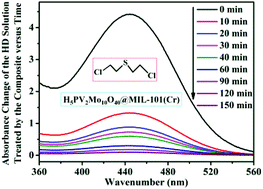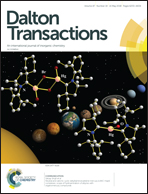H5PV2Mo10O40 encapsulated in MIL-101(Cr): facile synthesis and characterization of rationally designed composite materials for efficient decontamination of sulfur mustard†
Abstract
Currently extensive effort is compulsively expended to decontaminate efficiently banned chemical war agents. In this work, H5PV2Mo10O40 molecules have been encapsulated in mesoporous MIL-101(Cr), which features two types of mesoporous cages (internal diameters of 29 Å and 34 Å) and microporous windows (diameters of 12 Å and 16 Å), leading to the formation of a new composite H5PV2Mo10O40@MIL-101(Cr) through a simple impregnation method. The composite was characterized thoroughly by elemental analysis, FT-IR spectroscopy, powder X-ray diffraction, scanning electron microscopy, energy dispersive X-ray spectroscopy, TG/DTA, and textural analysis thereby confirming the encapsulation of the H5PV2Mo10O40 into MIL-101(Cr). The decontamination efficiency of sulfur mustard (4 μL HD in 40 μL of petroleum ether) by 20 mg of the composite is found to be 97.39% in 120 min under ambient conditions. GC-MS analysis on the decontaminated products using 2-chloroethyl ethyl sulfide (CEES), which has been widely used as a simulant of sulfur mustard, showed that MIL-101(Cr) just decontaminates CEES by adsorption, while CEES can be decontaminated under ambient conditions by a synergetic combination of adsorption of MIL-101(Cr) and subsequent chemical oxidation degradation to nontoxic 2-chloroethyl ethyl sulfoxide (CEESO) due to the presence of highly dispersed H5PV2Mo10O40 within the composites.



 Please wait while we load your content...
Please wait while we load your content...